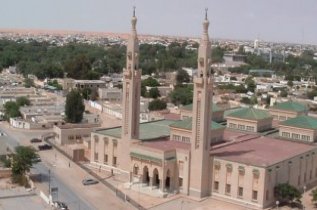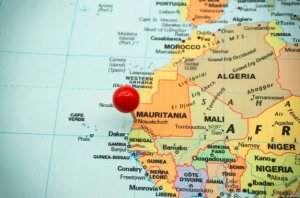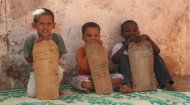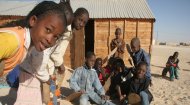|
Government ministries are concentrated in central areas and Nouakchott is home, perhaps unsurpringly, to the University de Nouakchott, the country's only national university although the city is also home to the private Lebanese International University, as well as acting as Mauritania's economic and administrative centre, with numerous markets, mosques, internet cafes and a cinema together with a stadium. Nearby is Nouakchott-Oumtounsy International Airport which connected to the city by the Sheikh Zayed Road. Three miles from the centre of Nouakchott is its port which was upgraded in the 1980s into a deep water harbour which is used mainly for imports.
 Despite significant investment, water supply, sanitation, and electricity remain critical challenges, particularly in rapidly growing peripheral neighbourhoods. Housing shortages are acute, leading to high rents and the expansion of self-built homes. Transportation primarily relies on shared taxis and minibuses, navigating the ever-present sand. The city is also enhancing its communication infrastructure. Despite significant investment, water supply, sanitation, and electricity remain critical challenges, particularly in rapidly growing peripheral neighbourhoods. Housing shortages are acute, leading to high rents and the expansion of self-built homes. Transportation primarily relies on shared taxis and minibuses, navigating the ever-present sand. The city is also enhancing its communication infrastructure.
Its climate is hyper-arid and hot, characterised by extremely low rainfall, often less than 100 mm annually. Temperatures frequently soar above 40°C during the long hot season (April to October). The coastal proximity provides some humidity but also brings sandstorms (harmattan) from the desert interior. Access to fresh water is a persistent challenge, with desalination plants and a pipeline from the Senegal River being crucial sources.
Nouakchott is a vibrant melting pot, reflecting Mauritania's diverse ethnic composition and youthful demographic, with a significant proportion of residents under the age of 30. The city is home to a mix of Arabic-speaking Maures (Bidan and Haratin) and various sub-Saharan African ethnic groups, including Pulaar, Soninke, and Wolof. This diversity is reflected in the city's lively markets, diverse culinary scene, and the multiple languages heard on its streets. While Hassaniya Arabic is most widely spoken, French remains important in administration and education, and national languages are commonly used within communities. Traditional Mauritanian hospitality, strong family ties, and Islamic values are central to the city's social fabric.
The economic lifeblood of Nouakchott is multi-faceted, heavily reliant on its strategic coastal location. Fishing is a cornerstone industry, with the city's port serving as a vital hub for seafood exports, particularly to European and Asian markets. The city's main port, Port de l'Amitié, handles the majority of Mauritania's imports and exports, making it crucial for national trade. Beyond fishing and port activities, Nouakchott's economy revolves around trade, services, and light manufacturing. The city hosts numerous informal markets, bustling with activity, alongside modern commercial centres. Government administration and public services also represent a significant portion of employment. Recent offshore oil and gas discoveries hold the promise of transforming Mauritania's economy, with Nouakchott poised to benefit as the primary logistical and administrative centre. However, challenges such as high youth unemployment, a large informal sector, and the need for further diversification persist.
 Nouakchott faces a unique confluence of environmental and developmental challenges. Climate change poses an existential threat, with rising sea levels directly imperilling its low-lying coastal areas and increased desertification pressing in from the east. The city's rapid, often unplanned, population growth strains its limited resources and infrastructure, leading to issues with waste management, access to clean water, and adequate housing. Unemployment, particularly among the youth, remains a significant socio-economic hurdle. Despite these formidable obstacles, Nouakchott demonstrates remarkable resilience. Its strategic location, burgeoning port, and the potential of newly discovered natural resources offer avenues for future growth and development. The government is investing in climate adaptation projects, urban planning initiatives, and diversifying the economy to create more sustainable opportunities. The city's future depends on its ability to effectively manage its growth, harness its economic potential, and adapt to the severe environmental pressures it endures. Nouakchott faces a unique confluence of environmental and developmental challenges. Climate change poses an existential threat, with rising sea levels directly imperilling its low-lying coastal areas and increased desertification pressing in from the east. The city's rapid, often unplanned, population growth strains its limited resources and infrastructure, leading to issues with waste management, access to clean water, and adequate housing. Unemployment, particularly among the youth, remains a significant socio-economic hurdle. Despite these formidable obstacles, Nouakchott demonstrates remarkable resilience. Its strategic location, burgeoning port, and the potential of newly discovered natural resources offer avenues for future growth and development. The government is investing in climate adaptation projects, urban planning initiatives, and diversifying the economy to create more sustainable opportunities. The city's future depends on its ability to effectively manage its growth, harness its economic potential, and adapt to the severe environmental pressures it endures.
|






 Despite significant investment, water supply, sanitation, and electricity remain critical challenges, particularly in rapidly growing peripheral neighbourhoods. Housing shortages are acute, leading to high rents and the expansion of self-built homes. Transportation primarily relies on shared taxis and minibuses, navigating the ever-present sand. The city is also enhancing its communication infrastructure.
Despite significant investment, water supply, sanitation, and electricity remain critical challenges, particularly in rapidly growing peripheral neighbourhoods. Housing shortages are acute, leading to high rents and the expansion of self-built homes. Transportation primarily relies on shared taxis and minibuses, navigating the ever-present sand. The city is also enhancing its communication infrastructure. Nouakchott faces a unique confluence of environmental and developmental challenges. Climate change poses an existential threat, with rising sea levels directly imperilling its low-lying coastal areas and increased desertification pressing in from the east. The city's rapid, often unplanned, population growth strains its limited resources and infrastructure, leading to issues with waste management, access to clean water, and adequate housing. Unemployment, particularly among the youth, remains a significant socio-economic hurdle. Despite these formidable obstacles, Nouakchott demonstrates remarkable resilience. Its strategic location, burgeoning port, and the potential of newly discovered natural resources offer avenues for future growth and development. The government is investing in climate adaptation projects, urban planning initiatives, and diversifying the economy to create more sustainable opportunities. The city's future depends on its ability to effectively manage its growth, harness its economic potential, and adapt to the severe environmental pressures it endures.
Nouakchott faces a unique confluence of environmental and developmental challenges. Climate change poses an existential threat, with rising sea levels directly imperilling its low-lying coastal areas and increased desertification pressing in from the east. The city's rapid, often unplanned, population growth strains its limited resources and infrastructure, leading to issues with waste management, access to clean water, and adequate housing. Unemployment, particularly among the youth, remains a significant socio-economic hurdle. Despite these formidable obstacles, Nouakchott demonstrates remarkable resilience. Its strategic location, burgeoning port, and the potential of newly discovered natural resources offer avenues for future growth and development. The government is investing in climate adaptation projects, urban planning initiatives, and diversifying the economy to create more sustainable opportunities. The city's future depends on its ability to effectively manage its growth, harness its economic potential, and adapt to the severe environmental pressures it endures.


